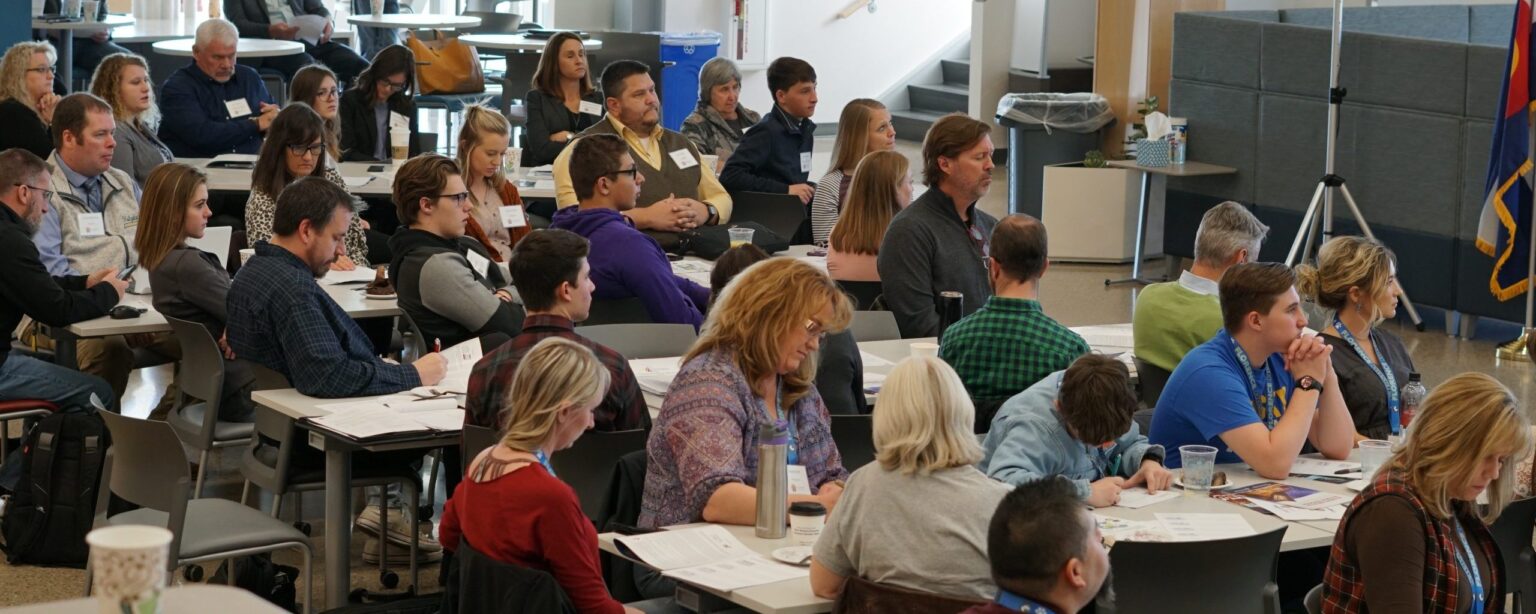Bringing Experiential Learning Opportunities to Colorado’s Rural Students
Homegrown Talent Initiative Communities Visit the Innovation Center of St. Vrain Valley Schools
In early March 2020, the Homegrown Talent Initiative’s eight community design teams convened at the Innovation Center of St. Vrain Valley Schools to experience a real-world example of career-connected learning.
The Homegrown Talent Initiative (HTI) is a state-wide project designed to dramatically improve access to pathways that lead to economic opportunity when students in Colorado leave high school – starting with rural communities.
Each participating district is working to build a graduate profile and connect local partners from across their communities, including K-12 representatives (students, educators, leaders, parents), businesses and higher education institutions to support their efforts to transform their students’ educational experiences.
St. Vrain’s Innovation Center: Courageous Leadership and Smart Innovation Drives Results
The morning began with an introduction to the Eight Dispositions that St. Vrain Valley School District (SVVSD) used to guide the creation of the Innovation Center and its program offerings. Patty Quinones, Assistant Superintendent of Innovation, explained that each Disposition, or “lever of change” was meant to “make change not only in our organization, but in our culture and our climate.”
It’s no secret that the Innovation Center was a massive financial undertaking, and the end result can seem unattainable to communities with limited resources. Jackie Kapushion, Ed.D., Deputy Superintendent, offered words of encouragement and explained that “Many times people will see we went from a $15 million deficit to this beautiful facility. It’s not always apparent how that happened. The Eight Dispositions are the ways in which we did that work.”
SVVSD’s Dispositions are:
- Innovation bolstering a strong foundation.
- Dynamic stability.
- A designer’s mindset.
- Synergy through partnerships.
- An asset-based approach.
- Diffusion of innovation
- Authenticity and relevance
- Systems thinking
Both leaders stressed that every district and community has different priorities and that their Dispositions would be different. To truly create innovation in education, districts must involve the community and other stakeholders in the process. For example, when talking about using an asset-based approach (Disposition #5), Dr. Kapushion shared that “You will never hear us go to our community and ask them to fix us, we go to our community and say, ‘This is what we’re going to do for you.’”
This approach has allowed SVVSD’s Innovation Center to become a bridge between education, industry, and the community. As a result, students have the opportunity to develop the skills, certifications, and expertise they need to solve real-world problems, both during school and into adulthood.
Next, Dr. Don Haddad, the district’s superintendent, shared the story of how the Innovation Center came to be – moving from a $15 million deficit to a system-wide change that has brought financial prosperity to the district.
When he took over at SVVSD, Dr. Haddad quickly realized that the community didn’t want to “fix” the district — they wanted to be part of a winning team. He needed to “shift the way we thought about education in St. Vrain.” Once he started talking about public education as an opportunity and investment, things changed.
As he spoke to the HTI group, Dr. Haddad shared some words of wisdom that would set the tone for the day: “Education, only second to parenting, is the driver and the catalyst for everything we are in America. Everything we are is dependent on great parenting and public schools.”
How the Innovation Center Empowers Students
After Dr. Haddad’s inspiring talk, participants split into two groups to tour the Innovation Center. We spent time in the center’s different rooms and labs, getting an inside look at spaces such as the Entrepreneurial Zone and Incubator Space, Robotics Lab, Multimedia Room (complete with a green screen), and Aeronautics Lab.
Administrators, teachers, and students from communities across rural Colorado were enthralled by the technology and tools available. Not only are SVVSD students able to access a flight simulator, drones, 3D printers, and biomedical science labs, they are empowered and paid to manage spaces that also serve as a learning center for younger students in the district.
Inside of the Mobile Lab, HTI community leaders heard from two students who manage the stations with the support of an adult staff member. The purpose of the lab is to bring the field trip experience to schools and communities for an “immersive, powerful moment,” with the goal of getting younger kids excited about learning.
Throughout the tour, participants eagerly started to identify ways in which they could bring new learning opportunities to their own districts. Whether it’s an unused classroom that can be used as a makerspace, or a local business partner who has expressed a willingness to provide resources, HTI communities are already thinking of new ways to innovate.
Exploring How Communities Can Innovate at Home
After the tour, each community’s participants reconvened for a series of group discussions. We talked about how to share stories from inside (and outside) the classroom, how to develop partnerships with local businesses, and then explored the “Eight Dispositions” in greater detail.
Later that afternoon, four students joined us to share their experiences at the Innovation Center and to answer questions. When asked about her experience, high school student Madison shared that “Classes here are way more hands-on, which I really appreciate because that’s the way I learn the best.” Cody, another high school student taking classes here, feels that he has been “given countless tools and resources” that have allowed him to acquire useful skills and “experience so much.”
The community design teams ended their day with a debrief of what they saw and learned, then used those insights to begin implementation planning. As they worked, students from each community expressed how cool they thought the Innovation Center was, and how excited they were to see what could be accomplished in their own communities.

